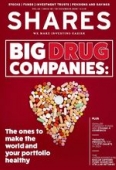Archived article
Please note that tax, investment, pension and ISA rules can change and the information and any views contained in this article may now be inaccurate.
Thematic products top the ETF charts in 2020

It’s been argued that the coronavirus pandemic has, rather than changing the world entirely, acted more like a time machine in accelerating trends so that shifts which might have taken years or decades have come through in a matter of months.
That argument is supported by the list of the best performing exchange-traded funds (ETFs) in 2020.
The shift to cloud computing, more spending on healthcare, increased use of artificial intelligence, the ongoing rise of China and greater online penetration in emerging markets were all trends experts predicted we would see in 2020. The pandemic appears to have turbo-charged them significantly.
It has also turbo-charged the performance of many ETFs tracking these themes, with a lot of them recording gains above 50% year-to-date.
A lot of trackers following broad market indices, the UK aside, have also done relatively well.
TOP PERFORMING ETF
Stripping out very niche products like cryptocurrency trackers and three-times leveraged ETFs – which are extremely volatile and come with a very high risk of loss – the best performing ETF has been iShares Global Clean Energy (INRG) with a return of 94% year-to-date.
This ETF tracks the S&P Global Clean Energy index, which is comprised of 30 large cap stocks and includes solar PV maker SolarEdge Technology, whose share price has almost trebled so far this year; and wind turbine manufacturer Vestas, which has more than doubled since hitting a low in the March sell-off.
Part of the reason these companies have done so well is the fact that solar and wind farms across the world are now becoming economically viable without government subsidies, a big tailwind for demand for solar panels and wind turbines as the world transitions to renewable energy.
But another big factor in their share price surge has been investor optimism over Joe Biden’s victory in the US election and the $400 billion clean energy spending plan he has pledged to push through Congress.
IN SECOND PLACE
The second best performing ETF this year has been WisdomTree Cloud Computing (KLWD), which has returned 86% year-to-date.
Cloud computing is the delivery of computing services – including servers, storage, databases, networking, software, analytics and intelligence – over the internet to offer faster innovation, flexible resources and economies of scale.
A lot of the big tech players like Amazon, Google and Microsoft all have big cloud computing businesses, but the WisdomTree ETF tracks the BVP Nasdaq Emerging Cloud index, which tracks more of the lesser known names in the space which due to their smaller size have potentially more significant growth potential ahead of them.
Its top three holdings are Cloudflare, Blackline and Zendesk, three young tech firms set up post-2000 which have seen their share prices soar this year. Cloudflare’s shares have risen over four-fold in 2020.
One of the benefits of ETFs is that they can be a lower cost way to access markets and investment themes than open-ended active funds.
Thematic or sector-based ETFs are often more expensive than products tracking major indices like the FTSE 100 but even for this ETF’s 86% return this year you would have had to pay a total annual fee of just 0.4% of your investment.
WHAT’S UNDER THE BONNET?
It’s important to research an ETF before investing and check what index it is following, and not just go by its name, as evidenced by both the WisdomTree Cloud Computing ETF and the other one available to UK investors, First Trust Cloud Computing (FSKY).
While the WisdomTree ETF has delivered an 86% return this year, the First Trust ETF – which has a 0.6% a year charge – has returned 47.1%. Still impressive, but significantly below the WisdomTree one despite both seemingly being a passive way to track the same industry.
The First Trust ETF follows the ISE CTA Cloud Computing index, which contains more of the bigger names like Oracle and Google owner Alphabet, companies which have seen decent share price growth this year but not anywhere near to the same extent as their smaller counterparts.
Unsurprisingly given 2020 has seen a once in a century global pandemic and the economic carnage that has ensued, gold has had a standout year, even if the rally is starting to fizzle out a little as vaccines provide hope.
IN THIRD PLACE
That means the third-best performing ETF this year has been Market Access NYSE Arca Gold BUGS ETF (GOLB), returning 79.1% year-to-date. It tracks the NYSE Arca Gold BUGS index, which is comprised of US-listed gold miners and includes Barrick and Newmont.
In fourth place is Invesco Elwood Global Blockchain (BCHS) with a 70.5% return year-to-date. It tracks the Elwood Blockchain Global Equity index and provides exposure to listed companies that participate or have the potential to participate in the blockchain or cryptocurrency ecosystem.
Blockchain was dismissed a couple of years ago as just hype and a short-term fad and, despite grandiose expert predictions, that appeared to be the same for much of this year.
But during November, the share prices of many blockchain stocks exploded in line with the rally in Bitcoin. Blockchain is the technology that enables among other things the existence of cryptocurrencies, Bitcoin included.
GAMING GAINS GROUND
Other top performing ETFs include VanEck Vectors Video Gaming and Esports (ESGB), which is also up 70.5% year-to-date.
A lot of its holdings aren’t necessarily pure play video game firms but instead have a chunk of their revenues from gaming, like top holding Tencent which is involved in many areas but among them is being the world’s largest video game seller; and Nvidia, whose stock has more than doubled year-to-date as its earning per share skyrocketed 130% year-on-year.
This was mostly down to its AI-driven data centre platform, but its gaming arm had also reported strong growth. Lindsell Train-backed Nintendo, a lockdown winner whose stock has risen 25% this year on higher sales growth, is also one of the top holdings in the ETF.
The rise of online penetration and the middle-class consumer in emerging markets has been reflected in the strong performance of EMQQ Emerging Markets Internet and Ecommerce ETF (EMQP) and KraneShares CSI China Internet (KWEB), both of which have benefitted greatly from exposure to China’s ecommerce giants Alibaba, Tencent, JD.com and Meituan Dianping.
TWO ETFs TO BUY
EMQQ EMERGING MARKETS INTERNET AND ECOMMERCE (EMQP) £13.03
The rise of the middle class consumer in emerging markets – from China to India to Latin America – is one of, if not potentially the biggest investment opportunity in the world today.
Respected consultant McKinsey says that by 2025 annual consumption in emerging markets will reach $30 trillion, something it calls ‘the biggest growth opportunity in the history of capitalism.’
One of the best ways to play this theme could be through EMQQ Emerging Markets Internet and Ecommerce ETF (EMQP).
It doesn’t come cheap with an ongoing charge of 0.86% a year, but this ETF has returned 67.6% year-to-date, following on from its 26% return last year, and is packed with some of the biggest growth names in the world.
The ETF’s holdings mean it is perfectly placed to capture the rise of the emerging market consumer, and its top five holdings include Chinese online shopping and ecommerce giants Alibaba, Tencent, Meituan Dianping, and Latin American equivalent MercadoLibre.
L&G HEALTHCARE BREAKTHROUGH (DOCG) £12.27
Innovation in healthcare has long been considered a crucial part of shaping the world of tomorrow. But having seen the havoc caused by the pandemic, you can bet dollars to donuts that improving and fundamentally reshaping healthcare for the better will shoot up the list of government priorities once it is largely over.
This has already been evidenced by the share price growth of many healthcare stocks this year, with those in the healthcare technology space seeing the best growth.
A great way to access this theme both for the here and now and longer term is through L&G Healthcare Breakthrough ETF (DOCG), which has returned 50.3% year-to-date for a total expense ratio of 0.49% a year.
Its tracks the ROBO Global Healthcare Technology and Innovation Index, which is comprised of companies across diagnostics, robotics, genomics, precision and regenerative medicine, lab automation, instruments, data analytics, and tele-health.
Disclaimer: Editor Daniel Coatsworth owns shares
in iShares Global Clean Energy ETF.
Important information:
These articles are provided by Shares magazine which is published by AJ Bell Media, a part of AJ Bell. Shares is not written by AJ Bell.
Shares is provided for your general information and use and is not a personal recommendation to invest. It is not intended to be relied upon by you in making or not making any investment decisions. The investments referred to in these articles will not be suitable for all investors. If in doubt please seek appropriate independent financial advice.
Investors acting on the information in these articles do so at their own risk and AJ Bell Media and its staff do not accept liability for losses suffered by investors as a result of their investment decisions.
Issue contents
Exchange-Traded Funds
Feature
First-time Investor
Great Ideas
Money Matters
News
- Supply chain issues could mean a bleak winter for UK consumers
- Big Goco shareholder Peter Wood throws weight behind Future tie-up
- Questions still linger over National Grid and SSE dividends
- Key catalysts for markets before the end of 2020
- Flutter Entertainment secures prize US asset
- Fast growing hydrogen stock Ceres gets closer to fulfilling its potential

 magazine
magazine









